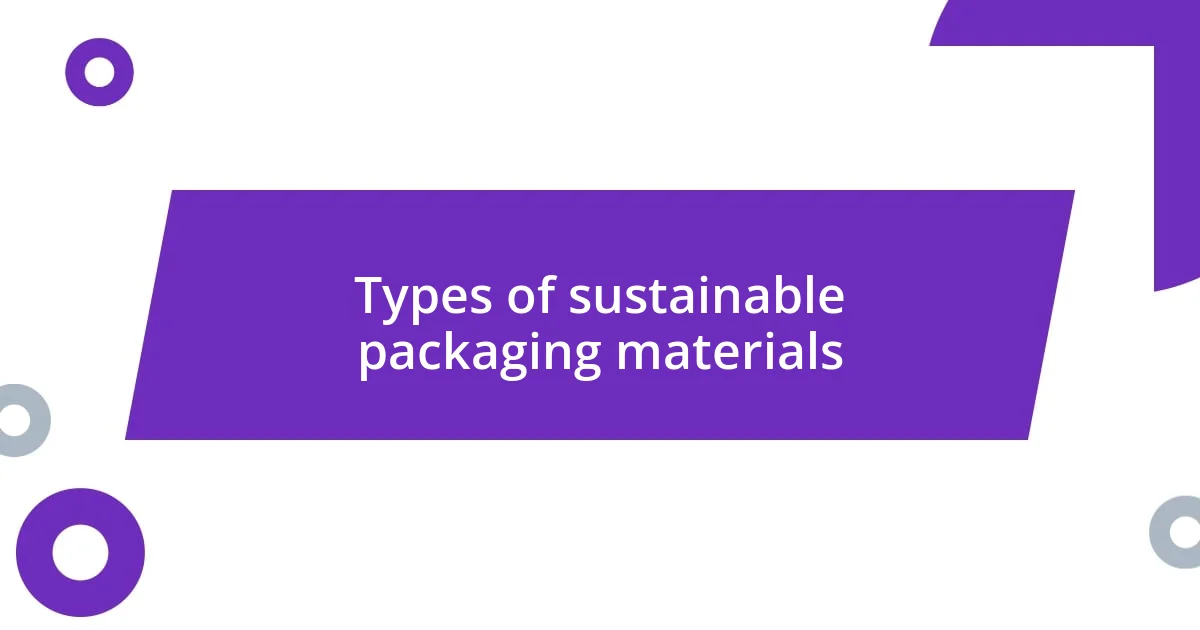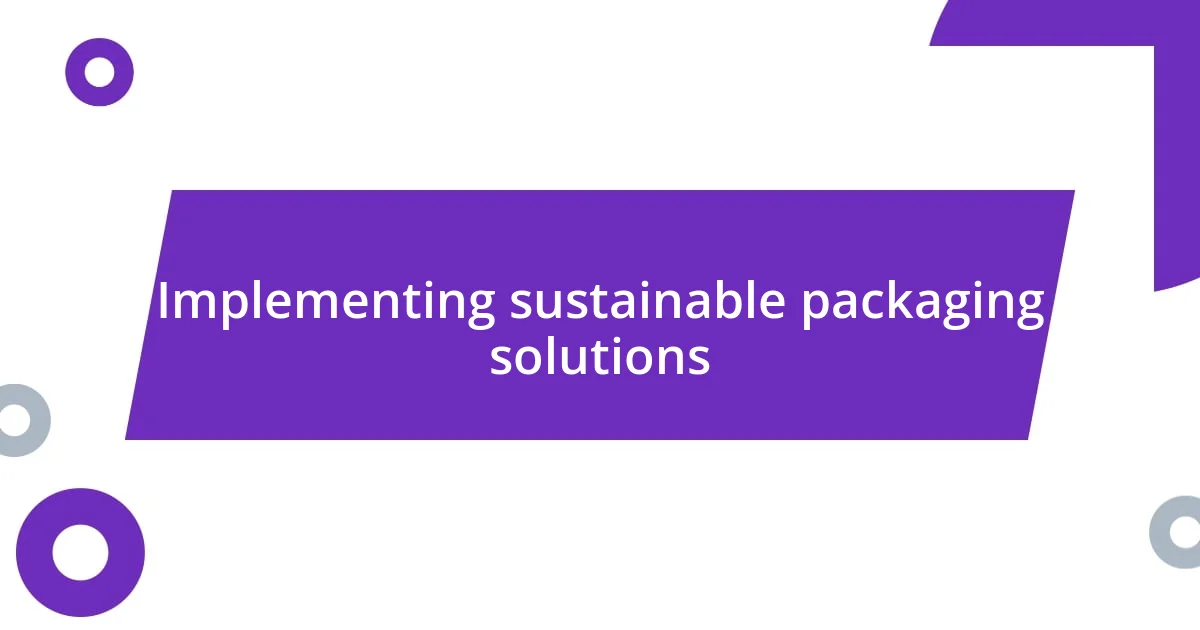Key takeaways:
- Sustainable packaging significantly reduces waste, fosters consumer-brand trust, and encourages innovative design solutions.
- Common sustainable materials include biodegradable plastics, recycled paper, plant-based materials, glass, and metal, each with unique environmental benefits.
- Future trends involve the rise of biodegradable packaging, the integration of technology for recycling education, and circular economy practices that promote reuse and return of packaging.

Understanding sustainable packaging benefits
When it comes to sustainable packaging, one of the standout benefits I’ve personally observed is how it significantly reduces waste. I remember visiting a local store that shifted to biodegradable materials, and it really struck me how something as simple as their choice in packaging could have such a profound impact on our environment. Can you imagine the difference if every business adopted similar practices?
Sustainable packaging also fosters a deeper connection between consumers and brands. Reflecting on my own experiences, I feel more inclined to support companies that prioritize eco-friendly options. It’s almost like an unspoken bond; I trust them more, knowing they’re taking steps to protect our planet. Doesn’t it feel rewarding to choose products that align with your values?
Moreover, these eco-friendly materials often lead to innovative design solutions. I was fascinated when I came across a brand using packaging that not only looked great but was also made from recycled ocean plastic. This creativity not only enhances brand image but also raises awareness about pressing environmental issues. Have you ever considered how much packaging can tell us about a company’s commitment to sustainability?

Types of sustainable packaging materials
Sustainable packaging materials come in various forms, each with unique advantages. I remember searching for groceries and feeling pleased when I found products wrapped in compostable materials. It feels good to know that my purchase won’t contribute to landfill waste; instead, it can break down and return to the earth.
Here are some common types of sustainable packaging materials:
- Biodegradable plastics: These break down naturally in the environment, reducing long-lasting waste.
- Recycled paper and cardboard: Using materials that have already been processed minimizes the demand for virgin resources.
- Plant-based materials: Items like cornstarch or sugarcane packaging are renewable and less environmentally taxing.
- Glass: While heavier, glass is infinitely recyclable and doesn’t leach harmful chemicals, something I appreciate for food safety.
- Metal: Often, aluminum can be recycled indefinitely, making it an excellent choice for both packaging and reducing environmental impact.
When I think about how different businesses choose sustainable materials, it’s almost like each choice tells a story. When I see a product in a chic, eco-friendly package, I can’t help but feel a sense of pride in supporting a brand that’s making responsible choices for our planet. It’s truly inspiring!

How to evaluate packaging sustainability
Evaluating packaging sustainability requires a keen understanding of various factors. One approach I often recommend is assessing the material’s lifecycle. For instance, I’ve witnessed a local coffee shop’s transition from single-use plastic cups to compostable ones. Watching them explain this shift to regular customers honestly gave me chills; it was clear that they considered not just the product but its entire environmental impact.
Additionally, understanding the certifications related to sustainable packaging can be crucial. I remember reading labels that claimed to be “recyclable,” but they didn’t have any credible certification. This realization pushed me to look for recognized symbols, like the FSC (Forest Stewardship Council) mark, which ensures that materials come from sustainably managed forests. It’s reassuring to know I’m making informed choices.
Lastly, consider the end-of-life options for the packaging. Optimization of these is vital! I once bought a product encased in simple, recyclable paper, and it felt satisfying when I could easily recycle it after using the product. Choosing brands that focus on minimizing their footprint becomes empowering; it’s a small, but meaningful way we can contribute to broader environmental efforts.
| Criteria | Description |
|---|---|
| Material Lifecycle | Assess the entire lifecycle of the material, from sourcing to disposal. |
| Certifications | Check for credible eco-certifications to ensure sustainable practices. |
| End-of-Life Options | Evaluate what happens to the packaging after use, focusing on recyclability and compostability. |

Implementing sustainable packaging solutions
Implementing sustainable packaging solutions is more than just a trend; it’s a vital step that many companies are embracing. I recall when my favorite snack brand introduced compostable wrappers—they even featured a little guide on how to properly dispose of them. It struck me how such thoughtful communication can elevate a brand’s relationship with its customers, fostering a sense of shared responsibility toward the environment.
I’ve also seen firsthand how the transition to sustainable packaging can lead to cost savings. One local business I frequent switched to reusable containers for takeout orders, which not only reduced their waste but also encouraged customers to return those containers for a discount. This approach not only delighted me as a consumer but made me wonder—why aren’t more brands adopting similar models? It seems like a simple win-win situation.
Lastly, collaborating with suppliers who prioritize sustainability is crucial. I find it fascinating how some companies work closely with their packaging partners to innovate eco-friendly solutions. It reminds me of a conversation I had with a friend who runs a small skincare line; she partnered with a local company that crafts beautiful, biodegradable packaging from wildflowers. It’s inspiring to see such creativity merge with sustainability, reinforcing that the journey to greener choices is truly a collective effort.

Real-world examples of sustainable packaging
One of the most exciting examples I’ve come across is the use of seaweed-based packaging by companies like Notpla. Imagine a world where instead of disposing of your food packaging, you could simply eat it! That’s the reality for customers who enjoy their takeout served in these innovative, biodegradable wrappers. I remember the first time I encountered this seaweed alternative, and honestly, it felt like a glimpse into the future. It ignites hope for packaging that doesn’t contribute to landfill waste.
Another compelling case is Coca-Cola’s commitment to using recycled materials in their bottles. Seeing them shift toward a target of using 50% recycled content by 2030 is encouraging. I often think about how our daily choices can influence big corporations. When I choose a product wrapped in recycled materials, I feel like I’m playing a small part in urging these giants to think differently about their environmental impact.
I was pleasantly surprised to learn about brands likeEleva, which packs their skincare products in aluminum containers. These containers can be recycled indefinitely without losing quality, which is a game changer for sustainability. I remember using one of their serums and appreciating not just its effects on my skin but the conscious choice behind its packaging. It made me ponder: how often do we consider our purchases’ packaging? Every small choice can accumulate and lead to significant change.

Future trends in sustainable packaging
Sustainable packaging is evolving rapidly, and I can’t help but feel excited about the rise of biodegradable materials. Recently, I caught up with a friend who mentioned how her favorite coffee shop now uses packaging made from corn starch. It got me thinking—how amazing would it be if all food chains followed this lead? These innovations not only reduce plastic waste but also inspire a cultural shift towards more conscious consumer choices.
Another trend I foresee is the integration of technology into packaging solutions. For instance, imagine packaging that not only keeps products fresh but also helps consumers understand how to recycle or repurpose it through QR codes. This idea resonates with my experience as a shopper; there’s a certain joy in knowing that my purchase is empowering me to make environmentally friendly decisions. Could this be the key to bridging the gap between product enjoyment and sustainability?
Lastly, circular economy practices are gaining more traction, where companies strive to create packaging that gets reused or returned. I once participated in a program where shopping bags could be returned for discounts. It dawned on me that this model could expand—what if brands offered incentives for bringing back packaging? This could spark a movement, wouldn’t it? It’s these little shifts that, when aggregated, can catalyze a substantial change towards a more sustainable future.














